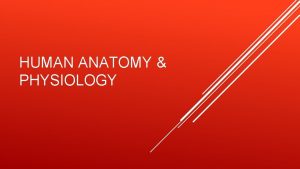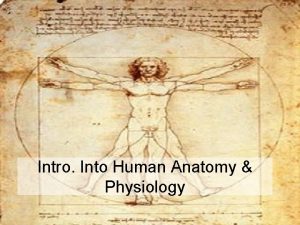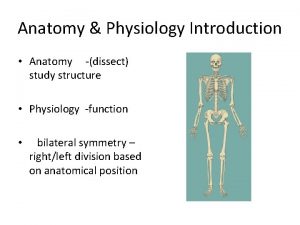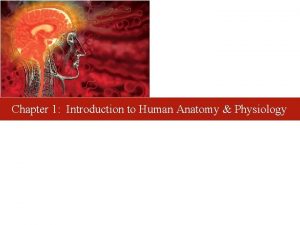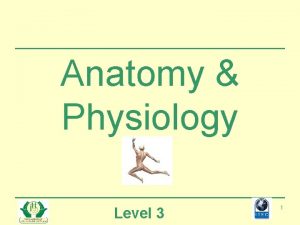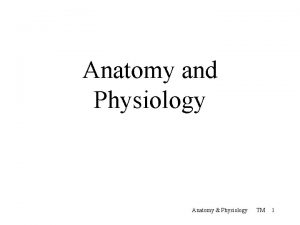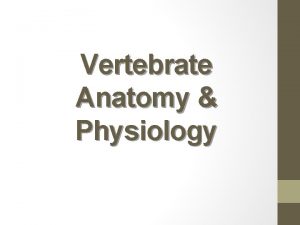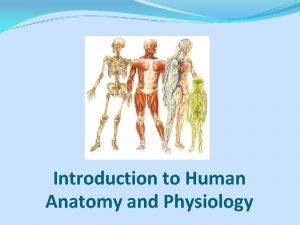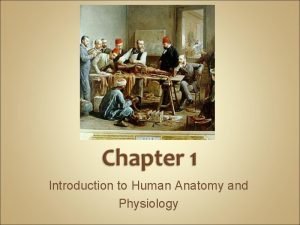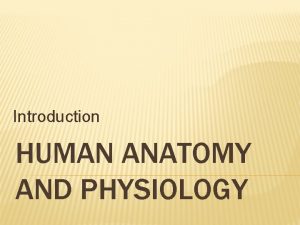Chapter 1 Introduction to Human Anatomy and Physiology












































- Slides: 44

Chapter 1 Introduction to Human Anatomy and Physiology

Anatomy and Physiology Terminology: Physiology vs Anatomy • Ancient Greek: physis, "nature, origin" logia, "study of" • Ancient Greek: ana, “separate, apart from” temnein, “to cut up, cut open” 2

Anatomy and Physiology • Anatomy deals with the structure of the body and its parts: what are things called? • Physiology studies the functions of these parts: how do they work? 3

Anatomy and Physiology • Anatomists rely on observation and dissection, while physiologists employ experimentation. 4

Levels of Organization The human body is the sum of its parts and these parts can be studied at a variety of levels of organization. Atom Molecule Macromolecule Organelle Cell Organism Organ System Organ Tissue 5

Anatomical Organization 6

Key Organ Systems in Human Anatomy • Body Covering a. The integumentary system, including skin, hair, nails, and various glands, covers the body, senses changes outside the body, and helps regulate body temperature. 7

• Support and Movement a. The skeletal system is made up of bones and ligaments. It supports, protects, provides frameworks, stores inorganic salts, and houses blood-forming tissues. b. The muscular system consists of the muscles that provide body movement, posture, and body heat. 8

• Integration and Coordination a. The nervous system consists of the brain, spinal cord, nerves, and sense organs. It integrates incoming information from receptors and sends impulses to muscles and glands. b. The endocrine system, including all of the glands that secrete hormones, helps to integrate metabolic functions. 9

• Transport a. The cardiovascular system, made up of the heart and blood vessels, distributes oxygen and nutrients throughout the body while removing wastes from the cells. b. The lymphatic system, consisting of lymphatic vessels, lymph nodes, thymus, and spleen, drains excess tissue fluid and includes cells of immunity. 10

• Absorption and Excretion a. The digestive system is made up of the mouth, esophagus, stomach, intestines, and accessory organs. It receives, breaks down, and absorbs nutrients. b. The respiratory system exchanges gases between the blood and air and is made up of the lungs and passageways. c. The urinary system, consisting of the kidneys, ureters, bladder, and urethra, removes wastes from the blood and helps to maintain water and electrolyte balance. 11

• Reproduction a. The reproductive system produces new organisms. i. The male reproductive system consists of the testes, accessory organs, and vessels that conduct sperm to the penis. ii. The female reproductive system consists of ovaries, uterine tubes, uterus, vagina, and external genitalia. The female reproductive system also houses the developing offspring. 12

Fig. 1. 19

Characteristics of Life and Homeostasis

Characteristics of Life • Fundamental characteristics of life are traits shared by all organisms. So, what do bodies need to function? 15

Characteristics of life include: 1. Movement (internal or gross) 2. Responsiveness (reaction to internal or external change) 16

3. Growth & repair (increase or replacement of tissues without change in shape/function) 17

4. Reproduction (new organisms or new cells) 18

5. Respiration (use of oxygen; removal of CO 2) 19

6. Digestion (breakdown of food into simpler forms) 7. Absorption (movement of substances through membranes and into fluids) 20

8. Circulation (movement within body fluids) What Gets Moved? àOxygen àCarbon Dioxide àWastes àWater àNutrients àBlood/Lymph àetc 21

9. Assimilation (changing nutrients into chemically different forms) Well, maybe not that extreme… 22

10. Excretion (removal of metabolic wastes) Taken together, these 10 characteristics constitute an individuals metabolism. 23

Characteristics of Life Organ Systems Which organ system(s) contribute to each of the characteristics listed on the left? • Movement • Integumentary • Responsiveness • Skeletal • Growth • Muscular/Nervous • Reproduction • Reproductive • Respiration • Endocrine • Digestion • Cardiovascular • Absorption • Lymphatic • Assimilation • Digestive • Circulation • Respiratory • Excretion • Urinary

Homeostasis Imagine one day is very cold out, while the next day is very hot. What effect does that have on your body temperature? External environment – keeps changing Internal environment - remains stable. How? Body has “Homeostatic Mechanisms”

Homeostasic Mechanisms – monitor internal environment - corrects changes 3 Components of Homeostatic Mechanisms: • receptors • function? • control center • tells what a particular value should be • effectors • function?


Types of Regulation • negative feedback - checkpoint – most common! • ex. maintaining body temperature; release of most hormones, etc. • positive feedback – no checkpoint – blood clotting – labor

Example of Homeostasis Control of Body Temperature Control Center Hypothalamus Thermoreceptors What temperature does your body try to maintain? What changes occur when your body temperature is: - too high? - too low?

Organization of the Human Body

Organization of the Human Body • Major features of the human body include its cavities, membranes, and organ systems. 31

Body Cavities: • The body can be divided into two portions: – appendicular portion (upper and lower limbs) – axial portion (head, neck, and trunk) • dorsal cavity • ventral cavity 32

33

a. The dorsal cavity can be divided into two areas: 1) Cranial cavity 2) Vertebral canal 34

35

b. The ventral cavity is made up of the following: 1) Thoracic cavity Ø The mediastinum divides the thorax into right and left halves. 2) Abdominopelvic cavity Ø The abdominopelvic cavity can be divided into the abdominal cavity and the pelvic cavity. v A broad, thin muscle called the diaphragm separates the thoracic and abdominopelvic cavities. 36

Thoracic and Abdominopelvic Membranes 37

c. Smaller cavities within the head include the oral cavity, nasal cavity, orbital cavities, and middle ear cavities. 38

39

Anatomical Terminology • Relative Positions: 1. Terms of relative position describe the location of one body part with respect to another. 2. Terms of relative position include: superior, inferior, anterior, posterior, medial, lateral, proximal, distal, superficial (peripheral), and deep. 40

LATERAL MEDIAL SUPERIOR INFERIOR SUPERIOR LATERAL PROXIMAL MEDIAL ANTERIOR POSTERIOR DISTAL PROXIMAL DISTAL SUPERFICIAL DEEP INFERIOR SUPERFICIAL POSTERIOR DEEP ANTERIOR SUPERFICIAL LATERAL

Body Sections: 1. A sagittal section divides the body into right and left portions. 2. A transverse section divides the body into superior and inferior portions. It is often called a “cross section”. 3. A coronal section divides the body into anterior and posterior sections. 42

Body Sections

Body Regions 1. The abdominal area can be divided into nine regions. 44
 Chapter 1 introduction to human anatomy and physiology
Chapter 1 introduction to human anatomy and physiology Chapter 1 introduction to anatomy and physiology
Chapter 1 introduction to anatomy and physiology Chapter 2 human reproductive anatomy and physiology
Chapter 2 human reproductive anatomy and physiology Olecranal region
Olecranal region Endomysium
Endomysium Holes essential of human anatomy and physiology
Holes essential of human anatomy and physiology Human anatomy and physiology 10th edition
Human anatomy and physiology 10th edition Human anatomy & physiology edition 9
Human anatomy & physiology edition 9 The central sulcus divides which two lobes? (figure 14-13)
The central sulcus divides which two lobes? (figure 14-13) Anatomy and physiology chapter 8 special senses
Anatomy and physiology chapter 8 special senses Chapter 13 anatomy and physiology of pregnancy
Chapter 13 anatomy and physiology of pregnancy Anatomy and physiology chapter 2
Anatomy and physiology chapter 2 Heat and cold
Heat and cold Art labeling activity: figure 14.1 (3 of 3)
Art labeling activity: figure 14.1 (3 of 3) Chapter 10 blood anatomy and physiology
Chapter 10 blood anatomy and physiology Anatomy and physiology chapter 15
Anatomy and physiology chapter 15 Necessary life functions anatomy and physiology
Necessary life functions anatomy and physiology Holes anatomy and physiology chapter 1
Holes anatomy and physiology chapter 1 Gi tract histology
Gi tract histology Pectoral girdle acetabulum
Pectoral girdle acetabulum Chapter 6 general anatomy and physiology
Chapter 6 general anatomy and physiology Upper and lower airway diagram
Upper and lower airway diagram Tattoo anatomy and physiology
Tattoo anatomy and physiology International anatomy olympiad
International anatomy olympiad Perfect vs imperfect flower
Perfect vs imperfect flower Bone metabolism
Bone metabolism Anatomy of peptic ulcer
Anatomy of peptic ulcer Cantlie line
Cantlie line Epigastric region
Epigastric region Difference between anatomy and physiology
Difference between anatomy and physiology Straw colored fluid
Straw colored fluid Http://anatomy and physiology
Http://anatomy and physiology Appendectomy anatomy and physiology
Appendectomy anatomy and physiology Aohs foundations of anatomy and physiology 1
Aohs foundations of anatomy and physiology 1 Aohs foundations of anatomy and physiology 2
Aohs foundations of anatomy and physiology 2 Anatomy and physiology of swine
Anatomy and physiology of swine Unit 26 animal anatomy physiology and nutrition
Unit 26 animal anatomy physiology and nutrition Science olympiad anatomy and physiology 2020 cheat sheet
Science olympiad anatomy and physiology 2020 cheat sheet Anatomy and physiology of stomach ppt
Anatomy and physiology of stomach ppt Anatomy and physiology diabetes
Anatomy and physiology diabetes Aohs foundations of anatomy and physiology 1
Aohs foundations of anatomy and physiology 1 Aohs foundations of anatomy and physiology 1
Aohs foundations of anatomy and physiology 1 Anatomy and physiology
Anatomy and physiology Cornell notes for anatomy and physiology
Cornell notes for anatomy and physiology Anatomy and physiology unit 7 cardiovascular system
Anatomy and physiology unit 7 cardiovascular system

















































